#cetacean rehab
Note
Please share all you can about Toa the orca calf, I think his story is very important. I don’t know too much but it seems like a case of activists being but in charge rather than actual experts.
Yeah it was a mess from start to finish. Toa was found stranded on the rocks, with witnesses saying the waves had thrown him up there. Already he would have been distressed and had been on his side on a hard surface for a few hours at least.
They got him back in the water and then videos of these interactions started to surface:
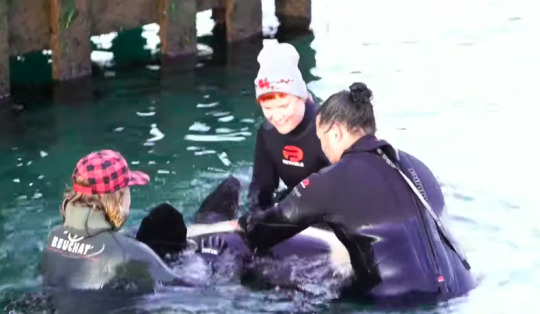
No PPE, giving Toa belly rubs and ignoring any formal rescue protocols (if you're trying to refloat a whale, you're not letting them turn upside down)
The sun was going down and DOC wanted people out of the water. Ingrid was on her way and giving instructions to her team. The decision was made to put Toa on a trailer overnight - it's unclear if that was her decision or not but it's clear that, despite not having any rehab facilities in New Zealand, people were determined to rehab this calf and release it back into the wild at any cost.
So they cobbled together a "sea pen" on a boat ramp in a dirty harbour. This is where Toa would eventually die in a few weeks time. Whale Rescue was already selling the story of a miraculous rescue and the plan to "reunite" Toa with his pod. And lying openly that orca calves had been successfully released in the wild before:
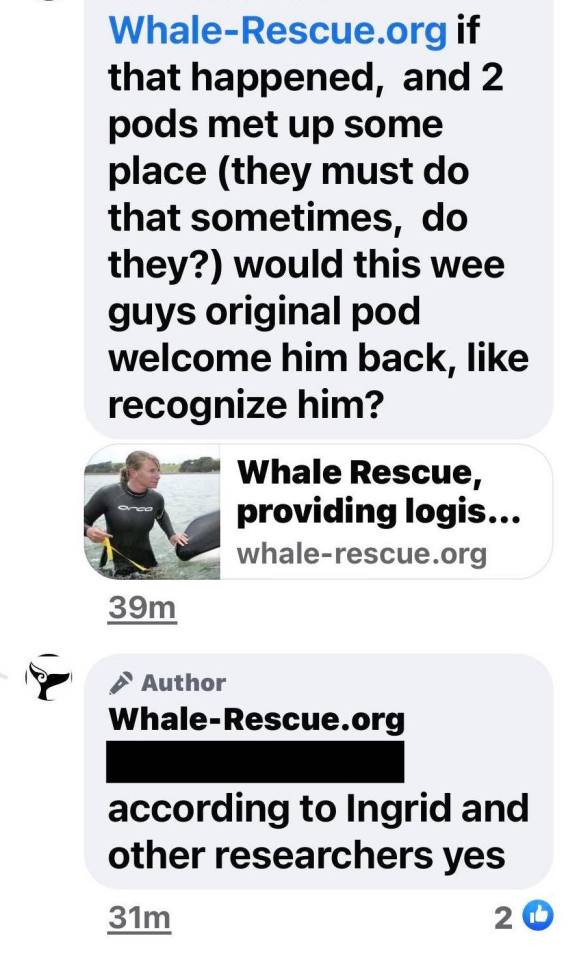
He wasn't injured, they said. He was fine. They just had to find his pod now.
When asked reasonable question about where the PPE was for volunteers, Whale Rescue immediately became defensive:
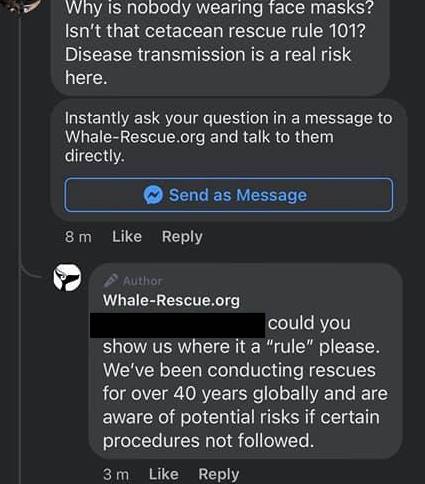
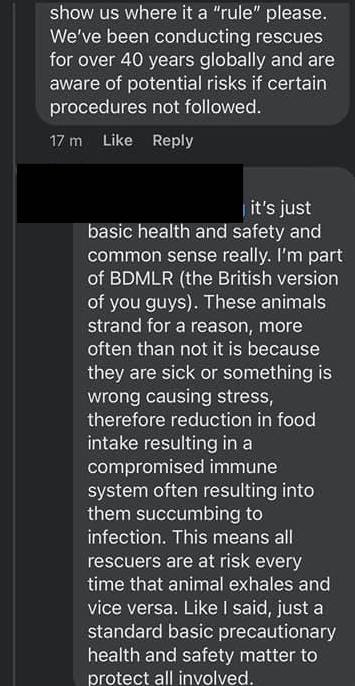
The call for PPE went ignored for about a day while people were in close contact with a sick orca. And the call went out for more "volunteers" aka anyone with a wetsuit. This sparked immediate concerns from the Advisory Group.
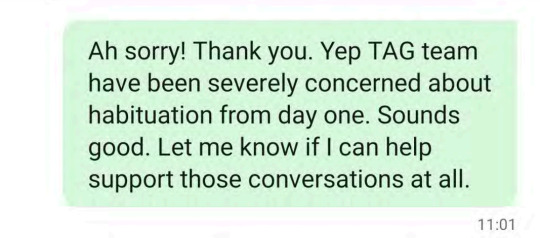

Photos like this started showing up - 6 people crowding Toa in a circle, no where for him to go if he wanted a break from people:
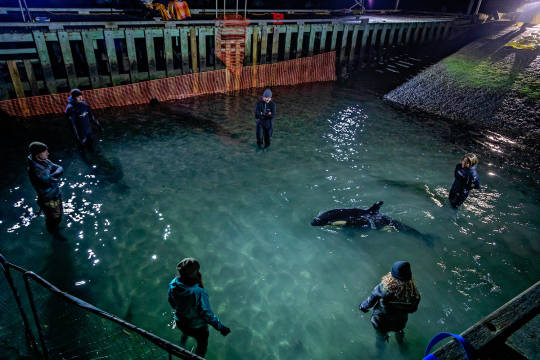
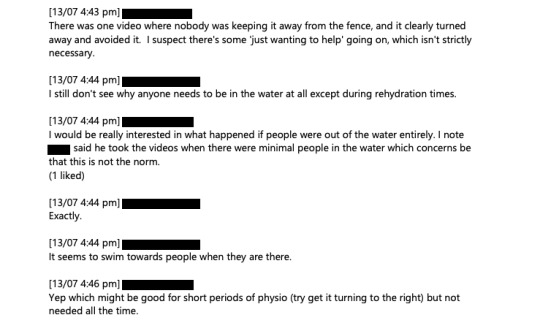
The excuse was that Toa needed help swimming. Yet he was swimming okay and avoiding the fences without any obvious issue. And so the habituation began... Despite continuing advice from the Technical Advisory Group - including Loro Parque and SeaWorld, who both have extensive calf raising experience.
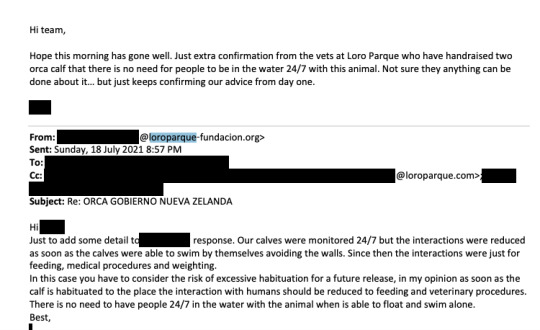
"There is no need to have people 24/7 in the water when the animal is able to float and swim alone."
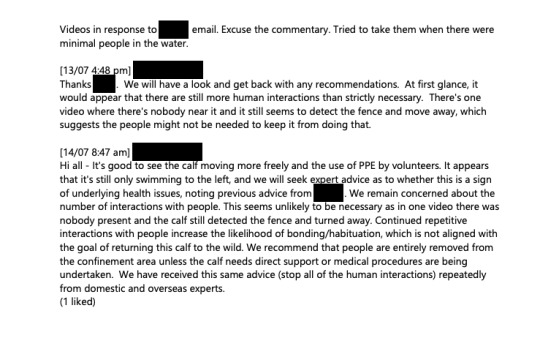
Finally PPE was being used but the habituation and intense contact with Toa continued. Ingrid gave it the okay and other inexperienced members of the public continued to encourage it.

Whale Rescue continued to affirm to the public that they are merely "duplicating natural behaviour" for Toa
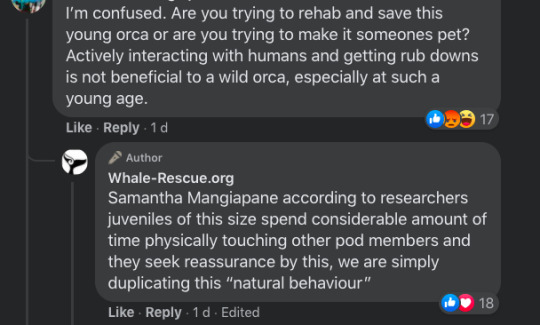

And the cultish and unquestioning worship of Ingrid Visser allowed this to continue - note the amount of people in the water for Toa's "massage." They only started wearing PPE when people started questioning it.
If you're wondering what I mean by cultish behaviour see the comment thread below:

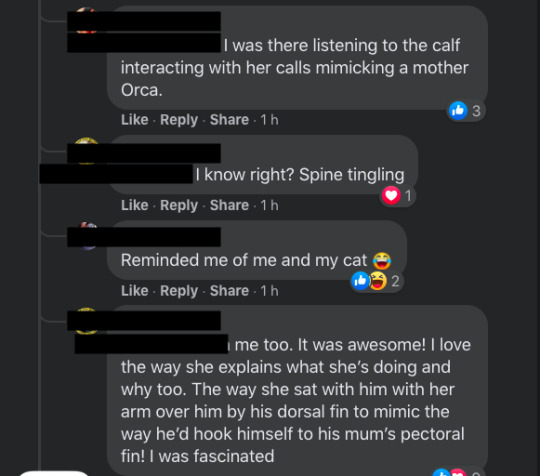
They actually believe that Ingrid was communicating with Toa. Because that's what she told them she was doing. And they believed it without question.
When Toa was moved into the freshwater pool due to storms, it got even worse.
This photo was quickly deleted but look how absolutely foul the water is:
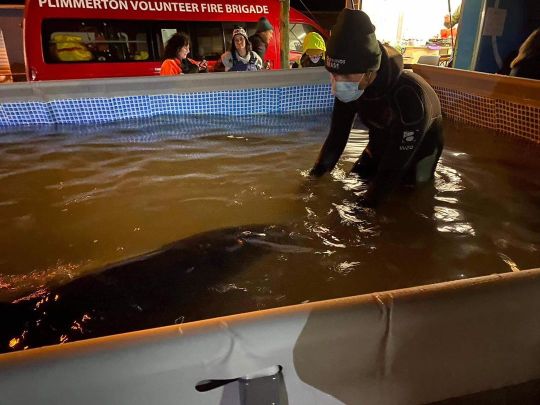
There didn't appear to be any sort of filtration or pump system.
At this point volunteers and Ingrid were being fed by donated food from the local pubs, Ingrid was sleeping on site in a donated campervan and the entire community were rallying around trying to "help." Note how close they're all set up to the pool.
Putting him in the pool also made Toa a lot more accessible. Concerns were raised about the stress to the calf and an exclusion zone was agreed upon. Buuut it was immediately disregarded.

7 people! In that tiny pool! And the photos of the complete flouting of the rules continued to surface.
The comments find it all very amusing!


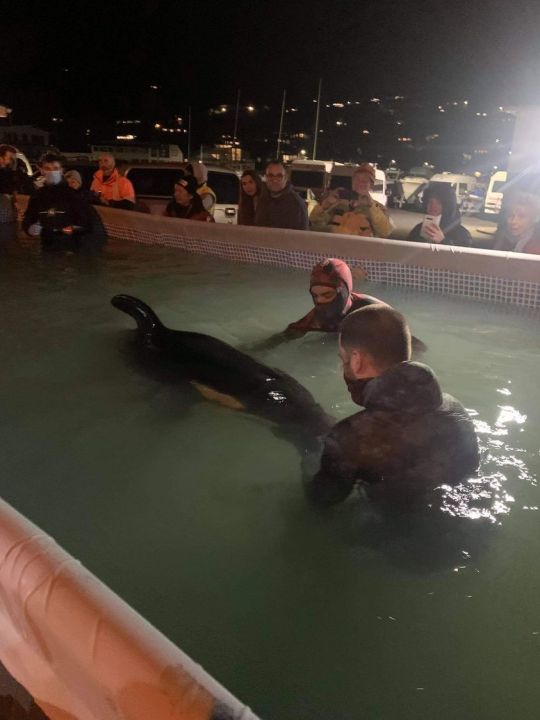
Roll up, roll up! Come and see the dying baby orca calf!
And then, as we near the end of this animal's torment, Ingrid brags to the press about how she's now TRAINING the animal she intends to release into the wild. Because we definitely want to be training cooperative care and making life saving feeding and hydrating procedures all about Choice.

Remember when Ingrid Visser didn't like the "exploitation" of orcas in captivity? Remember when she said that training "tricks", even husbandry behaviours, is cruel and bad? I do!
It makes me seriously wonder if she just wanted to be an orca trainer all her life.
But anyway, Toa's getting bouts of colic (gee, maybe changing the formula without permission wasn't a good idea!) and DOC is starting to get concerned about him. At this point, people are still denying that SeaWorld and Loro Parque are involved and any mention of a facility getting involved is immediately shut down.
This is what was being said in the Advisory Group:

At this point both SeaWorld and Loro Parque have provided formulas, advice ect. Ingrid Visser was claiming she knew these things all along and that the formulas were from her hand picked experts.
So these are what the comments were:
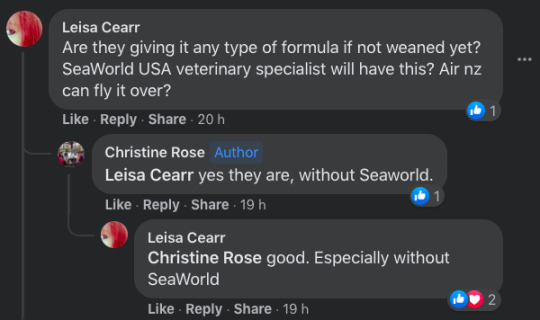
Whale Rescue thought it was appropriate to reply to comments of concern like this:

The cult of Visser continues to fuel the anti human care sentiment.
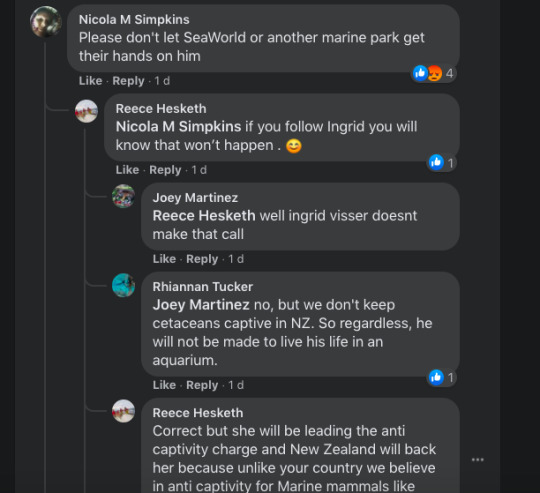
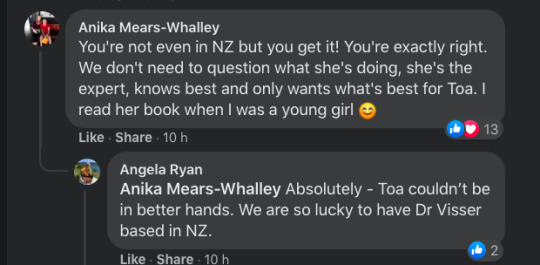
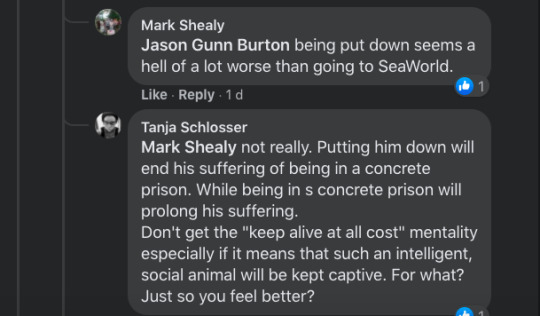
DOC starts to report concerns with Toa's health and Whale Rescue decides to double down that everything is completely Fine. Don't listen to DOC, keep giving us money.
The donations are getting up to 20k.
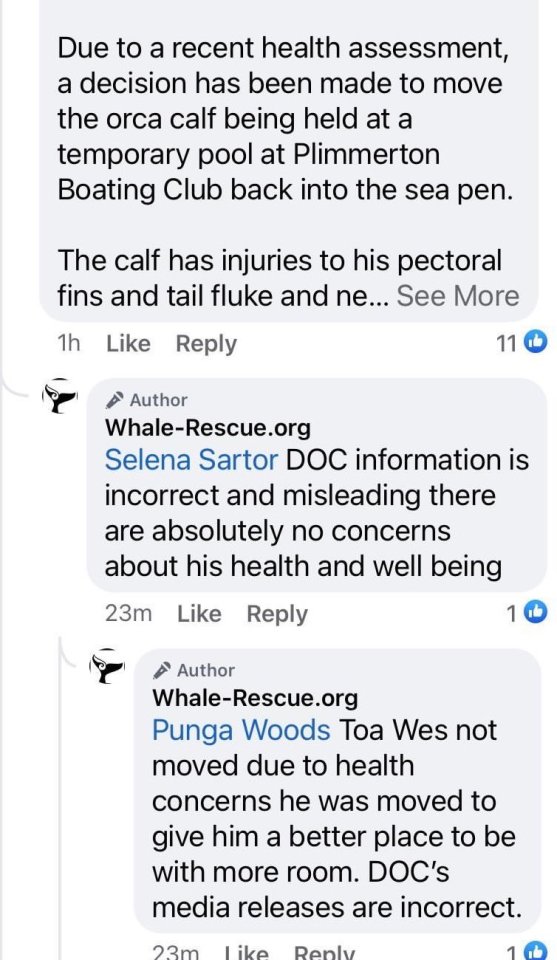

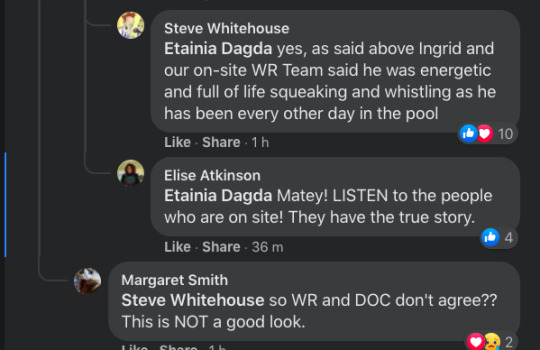
Because of Whale Rescue casting dispersions, anti DOC (Department of Conservation - who put in about 10k into the rescue efforts) sentiments grow.
And, only a few days later, Toa dies. I reached the end of my image limit but I still have plenty more screenshots I can share.
I recommend you check out the documents released by DOC to see the sources of these screenshots - the other screenshots were taken from news reports, Facebook groups and posts as well as videos:
#Toa#Toa the orca#cetacean welfare#orca#killer whale#Ingrid Visser#New Zealand#whale rescue#cetacean rehab#cetacean rescue
666 notes
·
View notes
Text
A plan is now in motion to airlift the 2-year-old orphaned orca calf trapped in a Canadian lagoon following the death of its mother to a sea pen, in hopes of releasing it when its family (a known pod of Bigg’s transient orcas) pass by. This is similar to what was done with Northern Resident orca “Springer,” who was successfully released and has gone on to live a normal wild life (even raising two calves!) Best of luck to this baby and everyone involved!
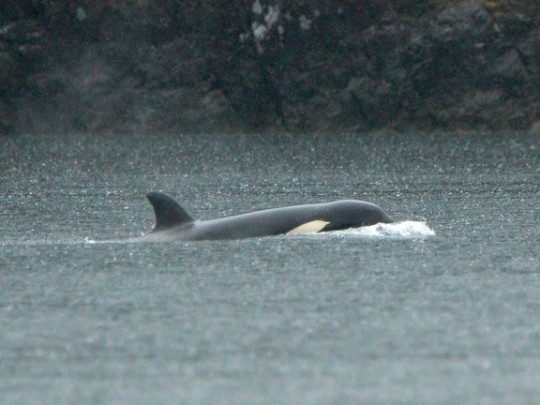
147 notes
·
View notes
Text
I think one of my favorite things about cetaceans (whales and dolphins) is the way they exhibit little signs of culture varying from pod to pod. For example, in the 80s there was a wild dolphin named Billie in Adelaide who was placed in dolphin rehab after being injured, and she spent some time amongst captive dolphins while recovering. Just from watching the Marineland dolphins, Billie learned to perform a trick called “tail walking” which is a behavior that dolphins don’t really do in the wild. However, when Billie was released back into Port River after her recovery, she loved tail walking so much that she taught it to all of the other wild dolphins in the pod as well as her daughter. Billie would regularly race up to boats and tail walk alongside them to the delight of passengers

There was a period for several years where pretty much all of the dolphins in Port River were tail walking on a regular basis until the fad eventually wore off, as fads do. Billie herself though never stopped exhibiting the behavior until her death in 2009 from renal failure. What a remarkable animal she was; I love what her story tells us about dolphin behavior and cognition.
#Billie the dolphin#cetaceans#dolphins#tursiops#animal behavior#animal cognition#biology#zoology#Australia#funny#cetacean
6K notes
·
View notes
Note
hi prev seaworld anon here, just did some reading and yeah i really jumped the gun sending that message and i apologize. i actually volunteered at a zoo that had dolphins and we had ara protesters show up at least once a year even tho we are aza accredited and take VERY good care of our dolphins(afaik.) i’ll definitely be doing more research instead of blindly believing reactionary articles, thank you
I think with all of the bad press that went around, people forget that seaworld is also an AZA facility and a licensed marine rehab.
They pretty much wrote the book on cetacean care, it’s very depressing how easy it is to remove context and just lie about a good organization to turn the public against them.
43 notes
·
View notes
Text
Do I own a very nice but apparently poorly-made chronometer?
Nope.
Do I have a side hustle as a SCUBA diver in a cetacean rehab facility?
Nope.
Do I currently inhabit a three-day weekend?
Yes.
Do I get irritated when people don't listen or follow instructions?
Hoo boy.
Did I spend all night dreaming that I was trying to apply ointment to the foreheads of several species of dolphin, and was being hassled by a beaked whale who wanted in on the action but who hadn't scraped the shit out of their melon?
You betcha.
Saturday night's dreamshit programming has been sponsored by the @montereybayaquarium and the makers of Neosporin.
3 notes
·
View notes
Note
I’m actually studying Marine Biology right now! I’m hoping to become one after all my uni years are over but I know it will take a while, I’m going into specializing in porpoises, whales and sharks! But I do have a question, I do really care for marine life and I remember we had to dissect a perch and I started to cry for the fish, some people say I’d be a great marine biologist because of that, but other people say I’m too sensitive to be one. What do you think?
Too sensitive? Umm absolutely not!!
All this tells me is that if you want to go into veterinary care, you may wan to reconsider. I myself cannot stand blood. The hardest part about being in marine mammal rehab was when we had animals with bloody injuries. This does not mean you can't go into the field!! For cetaceans and sharks you have options both in research and and husbandry (zoos and aquariums).
If you choose to go the research route, I want to share some scientists who are cetacean biologists so you can look at what they do!
Dr. Anne Simonis: NOAA biologist who studies sounds cetaceans make
Dr. Eugenie Clark: "The shark lady" shark behavioral biologist
Dr. Keith Hernandez: Elephant seal population ecologist
Dr. James Harvey: vertebrate behavior research and professor
I can look for other resources more specifically related to porpoises and sharks but I encourage you to take a look at these scientists have done or are doing now. You may find what they're doing to be of interesting.
Dagny
9 notes
·
View notes
Photo

Rimmy the dolphin deemed non-releaseable
June 12, 2018
Texas Marine Mammal Stranding Network on Facebook:
After 9 months of rehabilitation and care here at TMMSN, the National Oceanic Atmospheric Administration (NOAA) Fisheries has deemed Rimmy non-releasable due to a respiratory condition that will require long term care and treatment. Rimmy is a young animal that will benefit from socialization with other dolphins as she continues to receive treatment and returns to health. NOAA will choose her permanent home based on her particular social and medical needs.
Rimmy was initially found stranded and rescued from the McFaddin Wildlife Refuge beach near Sea Rim State Park in September 2017. She has been receiving care from our staff and volunteers since that time and we thank you all for your support and donations to her recovery. A CT scan and bronchoscopy completed early in the rehab process helped us to diagnose her extensive respiratory lesions for which she has been treated with antibiotics and anti fungal medication. She pulled through an extremely critical time and our staff is grateful that she is stable and making progress. We have started the process of relationship building to which she has been very responsive.
19 notes
·
View notes
Text
CW // animal death
So, I’ve said it before, and this may be an unpopular opinion, but I don’t think euthanasia or death is the worst thing to happen to an animal (long-suffering deaths and improperly done euthanasias aside). Im not saying it’s good, and it’s certainly sad, but it’s not bad either-it’s neutral.
I personally find it really uncomfortable how many people in the captivity debate want captivity to persist for unreleasable animals when euthanasia is an accessible and compassionate option. I’m not saying that cetacean rescue and rehab centres shouldn’t exist, but given that euthanasia is commonly employed in every other type of wildlife rescue, I find it… strange that it’s not commonly accepted for cetaceans (among people who debate captivity at least, and both sides too).
Winter’s death reminded me how prevalent this weird subtle anti-euthanasia mindset is among ceta people. And I want to be clear, that Winter’s death is tragic and heartbreaking and that I’m not trying to use her death as a soapbox; as I said, this is something I’ve mentioned before. However I’ve seen several people get huffy about whether or not it was cruel to keep Winter alive, so I think it’s important to bring this point up.
I also want to say that, as an anti-cap, CMA is probably the only facility I respect (despite its flaws), and I do not believe that I or anyone not directly working with Winter could determine what is better for her welfare. I think Winter probably lived a decent life. *I also don’t want people to think that support doesn’t euthanizing animals disabled enough to have a poor quality welfare can in any way be equated to disabled humans, don’t even fucking go there, disabled humans deserve to live and not have abled people call for their deaths thank you*
While I trust that CMA prioritized Winter’s welfare, I also have to admit that I’ve seen ARAs try to save similarly disabled animals and been (rightfully) called out for poor animal welfare (by procaps)-for example, horses and elephants with amputated legs that are given prosthetics. This is cruel, and in these cases the animals should have been euthanized and the resources spent on them distributed to other animals in need. While Winter was not a heavy quadruped, she no doubt developed problems like scoliosis that may have even contributed to her fatal GI problems. For these reasons I also questioned Winter’s situation, but she seemed to do well otherwise, so I wasn’t significantly concerned. It felt like one of those situations that toed the line and either decision can be justified-like an old dog with worsening arthritis, where you can tell the animal is happy but also in pain and you aren’t sure what’s the right decision, cause you don’t want to euthanize a happy healthy animal, but you don’t want an animal to suffer either. I also can’t deny that CMA definitely got publicity and money from Winter, which isn’t necessarily a bad thing, but to pretend like that isn’t potentially a factor in choosing to keep her alive despite health issues is disingenuous.
I don’t think CMA should have euthanized her instead of rescue, or euthanized her when she developed scoliosis, i don’t have an opinion on her situation at all cause it’s not my position to make those kinds of decisions.
But I also think that euthanasia would not have been the wrong decision. And it does concern me that ceta folks balk so much at the idea that euthanasia is also a kind, potentially even kinder, option for animals like Winter. A good death is always better than a shitty life.
13 notes
·
View notes
Note
tell me more about your love for marine bio, I’m curious! Like when in started?
So i live on the east coast, very near a bunch of beaches. I also live near my states institute for marine science, which only helped grow my love of the ocean. What really got me hooked was the dolphin tale movies. I watched them when i was younger and just fell in love with the ocean and all its creatures. I’m homeschooled so that lets me take random marine bio classes and do a lot of learning on my own. I visited CMA* (Clearwater marine aquarium) when i was like nine and loved it. Ive fallen in and out of love with marine bio for the last couple of years, but i rewatched the movies in quarantine and fell back in love. I’m actually going to cma’s career shadow program this summer witch I’m insanely excited about!
Rn my dream job is either animal care director at cma, or helping with research on cetaceans in captivity
*while i am all for the empty the tanks movement, cma actually does live up to their standards of rescue rehab release, unless they cannot release a patient for medical reasons
2 notes
·
View notes
Note
Hey what’s your stance on SeaWorld and their killerwhales n stuff do you think animals that big can have their needs adequately met in captivity?
So, SeaWorld does a great amount of good in the rehabilitation of sea life. One cannot deny that. And a lot of their enclosures are up to AZA standards.
However...
I don’t believe cetaceans should be kept long term in captivity. Especially in the case of orcas. They just have too specialized diets and cultures to mentally thrive in captivity. Nobody is going to breed pinnipeds to feed to the orcas who come from pinniped hunting populations. Putting together a group of orcas from a mishmash of cultures usually ends in fights. Not to mention the fact that SeaWorld promised to upgrade their orcas to a huge saltwater enclosure, which they then cowardly backed out of once they ended their breeding program.
The trainers and keepers of cetaceans are doing their best, and love their animals. But cetaceans are just one of those animals who don’t thrive in captivity.
Personally, I think SeaWorld should continue to keep cetaceans but only if they shift their focus to rehabilitation. They could take in beached, injured, and sickly animals and rehab them like they do their turtles and pinnipeds. Obviously there will be individuals who are too ill to be returned, so those should be kept in as big as possible naturalistic habitats that SeaWorld originally promised. SeaWorld could also use their rehab and return policy to bring attention to the plight of endangered cetaceans, like the Southern Resident orcas
54 notes
·
View notes
Note
Do you support the Clearwater Marine Aquarium? They recently announced that they will be transferring their dolphins to a 1.5 million gallon tank, and then to a sea sanctuary.
I know they’re creating an expansion and that their dolphins will live there, but I’d not heard about the sea sanctuary. Isn’t it just (possible) sea pens to help with their rehab work?I don’t really have a strong opinion on CMA. I’ve heard it’s very educational but having never been, I’m skeptical-as-always. I have a lot of reservations about the whole “rescued dolphin movie-star” thing. I mean, in general I find the whole “large financial incentives for rescuing animals” thing to be a problem.I don’t presently support many facilities that hold cetaceans. But my support of any facility (zoo, aquarium, etc) is malleable depending on its behavior and what I learn about it.
12 notes
·
View notes
Text
Any time I see someone worshipping Ingrid Visser I remember the time her organisation, under her advice, kept an orca calf on a mattress in a horse trailer overnight because they wanted to “rehabilitate” him/put him in a makeshift sea pen to treat like a pool toy until he died.

I remember when videos showed up of newly named Toa vocalising (usually a sign of stress) and her cooing and making nonsense noises at him. And the comments were like “she’s talking to him!!!”
Ingrid also insisted of making Toa interact with people despite him being a very sick baby orca who was slowly dying.
This was later confirmed by people who were there:

I remember when untrained volunteers were crowding this stressed sick orca calf, bragging about swimming with him and bonding with him and ignoring advice to stop habituating him.
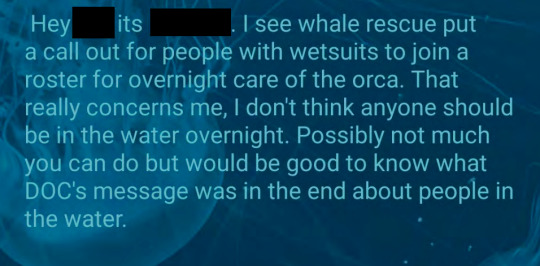

They had young kids in with him that didn’t know better and were told by Ingrid to interact with him like this. They were also laughing about how he “snored.” (Cetaceans don’t snore - anything that sounds like snoring is respiratory distress).
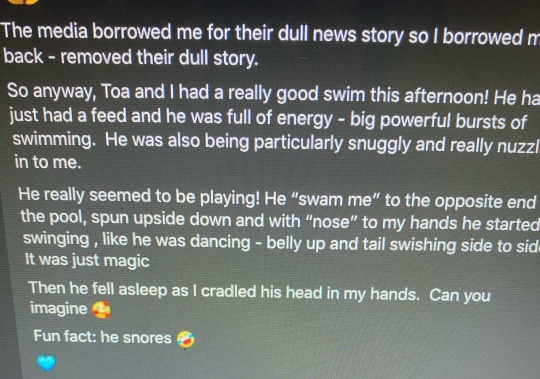
(Funny how waterwork is only okay when they do it with the stressed and dying orca calf but not in SeaWorld.)
The pathetic attempt to rehabilitate this dying calf by treating him like a pet, putting him in a tub of freshwater that quickly became toxic with ammonia. Signing off feeds with belly rubs and formulas changed behind the backs of the actual experts from Wellington Zoo and the experts consulted overseas who actually have successfully rehabbed calves.

How Whale Rescue (Ingrid’s organisation) lied again and again about Toa’s health and chances to be rehabilitated and released. How they misrepresented information about habituation when rehabbing whales and how Ingrid wanted to “train” Toa, despite plans to release him. How they demonised SeaWorld and claimed they weren’t involved despite records showing that SeaWorld and Loro Parque vets had provided their formula recipes and calf rearing protocols.


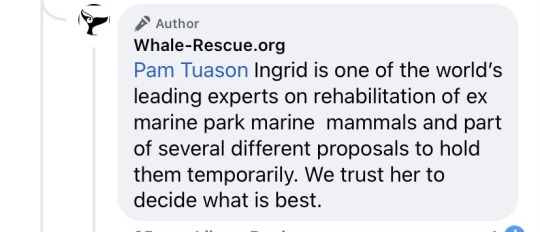
None of this is true - Ingrid has never rehabilitated any whale from a marine park. All the information she was getting was from DOC and the advisory group team

I could go on but I hit my image limit.
Basically: Ingrid’s “expertise” misled the New Zealand public, bullying out the actual experts so she could play orca trainer with her new pet.
#I have the receipts#I’ll never forgive what she did to Toa#or any of the orca calves that were unfortunate enough to be Rescued by her only to be treated like a pet#Toa#orca#killer whale#Ingrid Visser
159 notes
·
View notes
Text
In happier beluga related news, Tyonek the beluga recently celebrated 5 years at SeaWorld San Antonio! In 2017, Tyonek was found stranded as a neonatal calf, in such poor condition that the individuals who found him initially believed he was dead. He was nursed back to health by the dedicated team at the Alaska SeaLife Center (as well as experts from other aquariums who flew in to assist!) and, after being declared non-releasable by NOAA due to his incredibly young age at stranding, moved 4,000 miles south to SeaWorld San Antonio to join their pod of belugas and Pacific white-sided dolphins, which includes several experienced mothers and other youngsters to grow up with.
Tyonek is a member of the endangered Cook Inlet population of beluga whales and serves as a wonderful ambassador for his wild family, as well as providing valuable insights to researchers. He is the first beluga ever to be successfully rescued and rehabilitated!

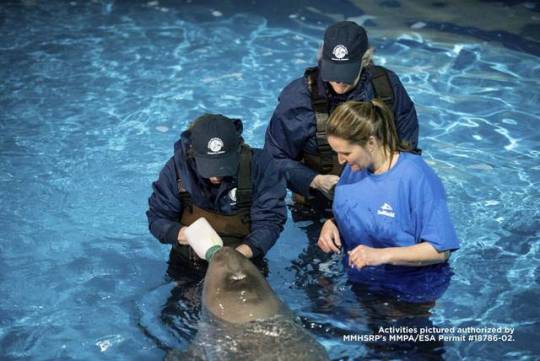
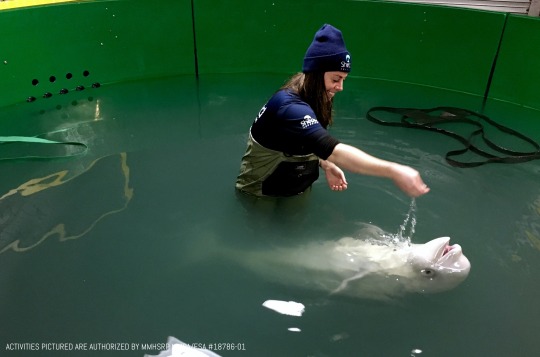

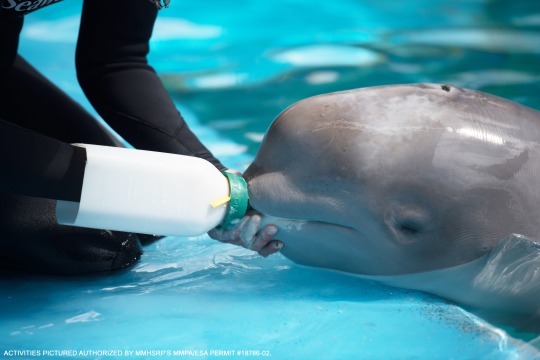
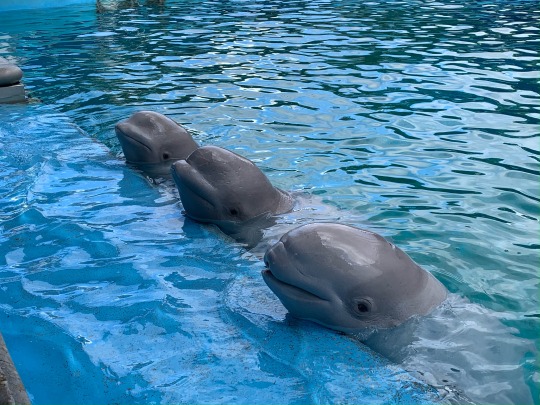
#belugas#cook inlet belugas#cetaceans#marine mammals#seaworld#alaska sealife center#wildlife rescue#wildlife rehab
50 notes
·
View notes
Text
WADTT’s Take: SeaWorld
If you’ve been following this blog for a while, you’ll know that I rarely comment on SeaWorld facilities. That’s always been because I never had any first-hand information from which to form opinions. In April, I finally got to visit a SeaWorld facility during the day, and I promised I’d come back with thoughts I would share publicly. I’ve been thinking in the intermediate months about what I was going to say, and it really comes down to this: I don’t know enough about how SeaWorld functions as a business entity, or the protocols underlying their animal management choices to have anything near a fully-formed, accurate opinion, but I am really damn impressed by the extent of the research the company does and by their marine mammal rehabilitation work.
Here’s what primary data I have that’s informing this conclusion: I’ve visited SeaWorld Orlando during a regular day, and Orlando and San Diego both during evening events as part of Association of Zoos and Aquarium (AZA) conferences; I attended the AZA 2015 annual conference in Orlando that was co-hosted with the International Marine Animal Trainer’s Association (IMATA) and sat in on presentations about SeaWorld’s animal management and research; was an IMATA member for a year in part to gain access to professional publications by the group; one of the past presidents of IMATA, who has a personal history working with cetaceans at Seaworld, is someone I know well enough to be able to ask questions of; I’ve sat in on the Marine Mammal Taxon Advisory Group session at this last mid-year AZA conference, which all SeaWorld facilities are part of / engage in and in which SeaWorld activities were discussed; I’ve had the chance to speak briefly with a couple of people from SeaWorld corporate at AZA conferences; I’ve done in-depth research into the standards of the three different accreditations and certifications SeaWorld facilities maintain (AZA, Alliance of Marine Mammal Parks and Aquariums, American Humane); I got to tour the rescue / rehab back area at SeaWorld Orlando through a normal guest program; I’ve observed and participated in discussions in private zoo groups about SeaWorld; I have friends who both have previously and do currently work for the company who let me pester them endlessly with questions.
And after all that? When it comes to the daily choices about animal care, or the higher-level management decisions, the main thing I’ve learned is how much I don’t know. I know everyone wants me to come back and have An Opinion - to be able to tell you that the SeaWorld company is either quantifiably perfect (that all the anti-SeaWorld propeganda and #EmptyTheTanks is lies) or quantifiably bad (that SeaWorld is mistreating their animals and lying to the public), but the reality is nowhere near as black-and-white as the parks’ most infamous residents.
If you’ve been around since the inception of WADTT, you might have noticed a change in how I talk about zoological facilities over the years: I no longer categorize places into good zoos and bad zoos, instead, making an effort to focus on the specific practices of each facility and help people decide if those are something they want to support. Zoo businesses are incredibly complicated. There are actually a whole bunch of pretty different business structures even within the zoo industry, and they all operate in totally different ways. SeaWorld facilities, at their core, are more of “water zoo” business structures than “amusement parks with some animal exhibits” types of facilities. (You can read more on how I break down those categories here). It’s worth noting here that while the public tends to think of ‘zoos’ and ‘Seaworld facilities’ as really distinct entities - and Seaworld as being larger than life as a brand - within the animal management industry, SeaWorld facilities really are just seen as part of the zoo world.
Zoological facilities that maintain primarily marine mammal collections by necessity function somewhat differently than zoos with mainly terrestrial collections. My area of familiarity, as someone who both researches the field and has been personally involved with animal care in zoos, is with terrestrial mammals. My experience in a zoo setting heavily informs the education I do on this blog, but it can only do so in a way where I’m accurate when my experience was pertinent to the topic being discussed. Because of how different some aspects of marine mammal husbandry are from those of terrestrial zookeeping, my experience with terrestrial mammals really isn’t relevant enough for me to make any assumptions about more than the most basic aspects of the daily work that goes into caring for cetaceans at a place like SeaWorld. And unfortunately, it’s really hard to get any relevant experience without actually getting a job working with marine mammals. Due to the current public mentality about zoological facilities that house cetaceans, it’s almost literally impossible to get behind the scenes to shadow and observe care at SeaWorld (at some facilities guest programs are possible, but those are super expensive and focused mainly on the guest’s experience and not on letting them observe normal routine). So when it comes to quality of animal care and what daily routines look like, the only primary sources I have for that are individual keepers who’ve been willing to have conversations with me - and that’s not a good representative sample from which to form an opinion about how animals at that facility operates.
Similarly, I don’t have data on exhibit design or breeding decisions. That information is very rarely accessible for terrestrial zoos - what I’m normally able to dig up is a testament to years of networking in the field and the trust I’ve built with some of the figures in the industry - and due to the political climate, SeaWorld understandably keeps a lot of information about their facilities close to the chest. I would love to be able to walk up to people involved at a really high level with the company and ask them why they do certain things, but I don’t have that access and doing so would be inappropriate. Sometimes these things are discussed at conferences; I’ve caught a session or two at AZA conferences, but the IMATA conferences that would provide the most information are hosted all over the world and I can only attend it the times it’s domestic to the United States.
What I do have data on, from the conference presentations I have caught over the years, is some of the higher-level management decisions made by the company about rescue and rehab and a whole lot of research that SeaWorld has done. And, honestly, what I did learn in those sessions is that the sheer amount of research and collaboration with experts from other institutions around the world is mind-blowing. That trend carries throughout all of my interactions with people from every echelon of the company I’ve gotten to interact with. Every single time I ask someone - anyone involved with SeaWorld - what I think is going to be a simple, straightforward question, I end up learning about things I didn’t know either existed or were even pertinent to the discussion. For someone who feels as well-educated about the science of animal management as I generally do, the amount that I am consistently learning is incredibly humbling.
So where does that leave my opinion? I still have a minimum of a couple years of research left before truly understanding cetacean care in captive settings, and how it sits relative to professional ethics about keeping any animal in human care. I haven’t gotten to observe any behind the scenes animal care, so I can’t speak to how the staff interact with their animals when not on public view. (I did get to observe some voluntary medical behaviors done during a training session in public view with the dolphins at the Nursery, and I’ll post those videos to Instagram.) I can’t parse the behavior of the animals I saw at the Orlando facility, because I have no professional background or training in cetacean behavior - during my visit, I had to trust the interpretation provided by the educators around me and the copious amounts of information I was given surrounding my trip by peers who do work professionally with cetaceans. Do I still have questions? Absolutely. But they’re questions at this point about the research and the background info and the over all “why” of choices, rather than questions about if how SeaWorld operates their facilities are “okay.”
So what I am willing to say publicly, what I can absolutely vouch for about SeaWorld is this: the people involved with animal care and management at SeaWorld facilities genuinely care for their animals and their well-being, and that the people making the important decisions from more managerial roles are truly experts in cetacean biology and management. Every time a choice about how resident animals are cared for - whether you or I agree with it or not - I can guarantee you that a huge amount of time, effort, and research has gone into informing that decision.
324 notes
·
View notes
Note
I'm watching lost media YouTubers, primarily nsfl ones (deals with gore) and just. Seeing the Dawn Branchau tilikum thing.
They don't know that her family says that they regret letting Blackfish use her footage.
They don't know that her family says she wouldn't want her death used to demonize SeaWorld or Tilikum.
They don't know that marine biologists defend SeaWorld.
The smear campaign against seaworld may very well be one of the most detrimental things done towards the field of understanding cetaceans in captivity and their husbandry as well as rehab. It’s a shame, I genuinely would call that documentary the nail in the coffin but I can at least hold a shred of hope that it will be forgotten with time. The whole thing was just handled so obnoxiously poorly.
49 notes
·
View notes
Text
Marine Mammals of Maine Internship Opportunity
Marine Mammals of Maine (MMoME) is a non-profit organization federally authorized to respond to live and dead marine mammals and sea turtles between Kittery and Rockland, Maine. MMoME covers some of the busiest seal stranding coastline, averaging 300 live and dead animals annually. MMoME also operates a triage and rehabilitation center which provides critical care to sick and injured pinnipeds. Additionally, our mission heavily encompasses research, education and outreach, and is dedicated to promoting environmental conservation. MMoME is offering 2 different internships for the 2019 summer harbor seal pup season.
Core Internship: seeking 6 motivated, flexible and independent interns for the months of May through August, or May through October. Interns are critical in fulfilling our mission and are given the unique opportunity to participate in a variety of activities. The internship is based out of Midcoast Maine (Harpswell), though travel throughout our response region and the Northeast will be necessary. Interns will be required to dedicate a minimum of 40-50 hours per week to the internship (minimum of 4 days/week), and will include holidays, weekends and night feeds. This internship is unpaid, though seasonal job opportunities are available in the area. Housing is not provided but staff may be able to assist with sourcing options.
KEY TASKS AND RESPONSIBILITIES:
· ANIMAL RESPONSE: respond to live and dead cetacean, pinniped and sea turtle strandings to collect Level A data, perform health assessments, and monitor, relocate, collect for humane euthanasia, or rescue. Carcass collection for disposal or necropsy will also be required;
· IN-HOUSE PATIENT CARE: assist with all aspects relating to the care of sick, injured and abandoned pinnipeds undergoing short, or long-term care at the center. Tasks include meal prep, tube-feeding, assisting with medical procedures, animal restraint for exams, running lab samples, medical record maintenance, cleaning, and transport to long-term care facilities;
· NECROPSY: transport carcasses to necropsy and compost sites, assist with necropsy of fresh dead pinnipeds and cetaceans, and archive necropsy samples;
· EDUCATION AND OUTREACH: give presentations to the public about the organization, attend outreach events, and help create educational materials;
· OTHER TASKS: additional time during this internship will be spent on data entry, fundraising, cleaning, and other tasks as needed.
REQUIREMENTS:
· The internship is open to undergraduate students currently enrolled in, or recently graduated (within 2 years) from an accredited college or university (this internship is not yet designed for those pursuing DVM degrees);
· The ideal candidate is working towards a career in marine mammal science, veterinary medicine, marine biology, environmental education, or related fields;
· Must commit to at least three months, and be available from May 13– August 15, or October 15. MUST be able to start no later than May 20th, 2019;
· Must have a valid driver’s license, a reliable vehicle, and comfortable driving a full-size truck in urban and rural areas;
· Must be able to work independently and as part of a team, and be adaptable to a changing and unpredictable schedule;
· Individuals that are passionate, responsible, hardworking, eager to learn, flexible, able to work under little supervision, and detail oriented are encouraged to apply;
· Preference given to individuals with a demonstrated interest in marine mammals, and are specifically interested in marine mammal response, rescue, and care. Previous marine mammal experience or animal husbandry a plus;
Advanced Marine Mammal Internship: MMoME is seeking Advanced Response and Care interns to start May 1st through September 30th (end date can be flexible). Advanced interns will also work 40-50 hours/week (4 days/week) including holidays, weekends, and night feeds. This internship is unpaid though seasonal jobs are available in the area, and housing is not provided but MMoME may be able to assist with sourcing options. The Advanced interns will carry out the same duties outlined for Core Interns, and additionally will assist staff with:
· Obtaining and processing diagnostic samples from stranded marine mammals, as well as triage and rehabilitation pinnipeds in MMoME’s care;
· Clinical procedures, injections, and fluid therapy;
· Dispensing oral medications as directed by MMoME staff and veterinarian;
· After-hours medical care of triage or rehab patients in need of extended critical care as directed by staff and veterinarian;
· Lead volunteer and intern shifts.
Requirements listed above for Core Internship apply for Advanced Interns, in addition to:
· Must be either a 4th year (or more) undergraduate student, a recent graduate within the last 4 years, or actively enrolled in a graduate program;
· Must have prior experience working directly with marine mammals, or experience working in a clinical setting with other wildlife;
· Must have demonstrated experience handling marine mammals or other large wildlife.
HOW TO APPLY:
Please send a letter of interest, resume and contact information for two references to [email protected] by February 8th, 2019. Your application should additionally include which internship you are applying for, and the start and end dates you can commit to for that internship. We look forward to your application for this exciting experience!
1 note
·
View note